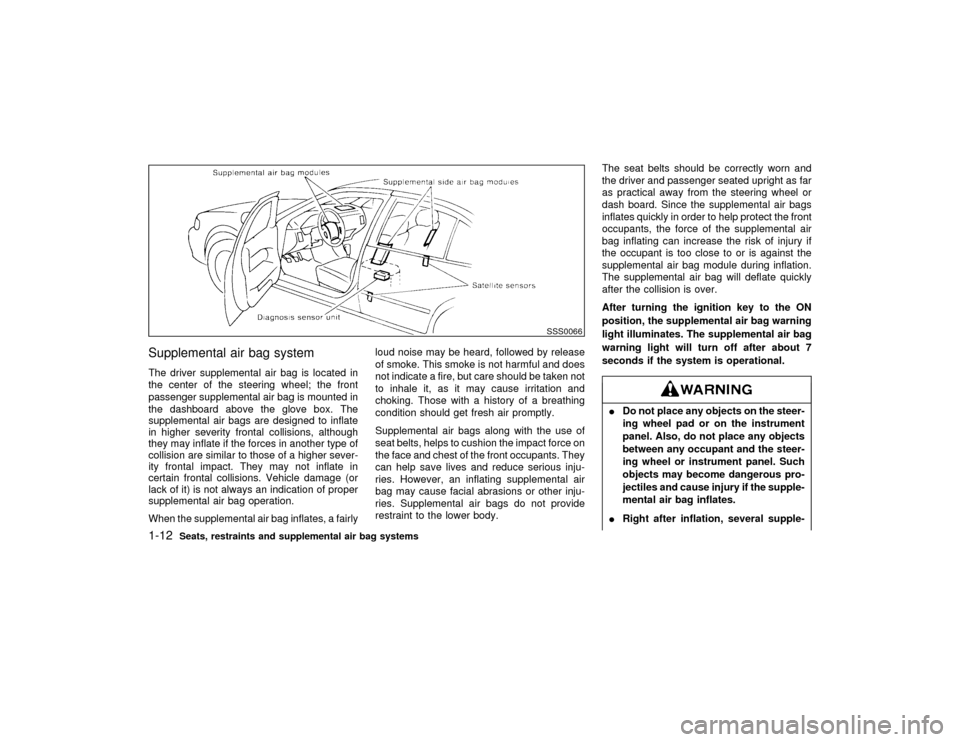1998 NISSAN MAXIMA air condition
[x] Cancel search: air conditionPage 6 of 231

Table of
Contents
Seats, restraints and supplemental air bag systemsInstruments and controlsPre-driving checks and adjustmentsHeater, air conditioner and audio systemsStarting and drivingIn case of emergencyAppearance and careDo-it-yourselfMaintenanceTechnical and consumer informationIndex
Z
01.1.31/A32-D
X
Page 19 of 231

Supplemental air bag systemThe driver supplemental air bag is located in
the center of the steering wheel; the front
passenger supplemental air bag is mounted in
the dashboard above the glove box. The
supplemental air bags are designed to inflate
in higher severity frontal collisions, although
they may inflate if the forces in another type of
collision are similar to those of a higher sever-
ity frontal impact. They may not inflate in
certain frontal collisions. Vehicle damage (or
lack of it) is not always an indication of proper
supplemental air bag operation.
When the supplemental air bag inflates, a fairlyloud noise may be heard, followed by release
of smoke. This smoke is not harmful and does
not indicate a fire, but care should be taken not
to inhale it, as it may cause irritation and
choking. Those with a history of a breathing
condition should get fresh air promptly.
Supplemental air bags along with the use of
seat belts, helps to cushion the impact force on
the face and chest of the front occupants. They
can help save lives and reduce serious inju-
ries. However, an inflating supplemental air
bag may cause facial abrasions or other inju-
ries. Supplemental air bags do not provide
restraint to the lower body.The seat belts should be correctly worn and
the driver and passenger seated upright as far
as practical away from the steering wheel or
dash board. Since the supplemental air bags
inflates quickly in order to help protect the front
occupants, the force of the supplemental air
bag inflating can increase the risk of injury if
the occupant is too close to or is against the
supplemental air bag module during inflation.
The supplemental air bag will deflate quickly
after the collision is over.
After turning the ignition key to the ON
position, the supplemental air bag warning
light illuminates. The supplemental air bag
warning light will turn off after about 7
seconds if the system is operational.
IDo not place any objects on the steer-
ing wheel pad or on the instrument
panel. Also, do not place any objects
between any occupant and the steer-
ing wheel or instrument panel. Such
objects may become dangerous pro-
jectiles and cause injury if the supple-
mental air bag inflates.
IRight after inflation, several supple-
SSS0066
1-12
Seats, restraints and supplemental air bag systems
Z
01.1.31/A32-D
X
Page 20 of 231

mental air bag system components
will be hot. Do not touch them; you
may severely burn yourself.
INo unauthorized changes should be
made to any components or wiring of
the supplemental air bag system.
This is to prevent accidental inflation
of the supplemental air bag or dam-
age to the supplemental air bag sys-
tem.
IDo not make unauthorized changes
to your vehicle's electrical system,
suspension system or front end
structure. This could affect proper
operation of the supplemental air bag
system.
ITampering with the supplemental air
bag system may result in serious
personal injury. Tampering includes
changes to the steering wheel and
the instrument panel assembly by
placing material over the steering
wheel pad, above the dashboard, or
by installing additional trim material
around the supplemental air bag sys-
tem.IWork around and on the supplemen-
tal air bag system should be done by
an authorized NISSAN dealer. Instal-
lation of electrical equipment should
also be done by an authorized
NISSAN dealer. The SRS wiring har-
nesses* should not be modified or
disconnected. Unauthorized electri-
cal test equipment and probing de-
vices should not be used on the
supplemental air bag system.
* The SRS wiring harnesses are cov-
ered with yellow insulation either just
before the harness connectors or
over the complete harness for easy
identification.
When selling your vehicle, we request that you
inform the buyer about the supplemental air
bag system and guide the buyer to the appro-
priate sections in this Owner's Manual.Supplemental side air bag systemThe supplemental side air bags are located in
the outside of the seatback of the front seats.
The supplemental side air bag (on the driver or
front passenger seat) is designed to inflate in
higher severity side collisions, although it may
inflate if the forces in another type of collisionare similar to those of a higher severity side
impact. It is designed to inflate on the side
where the vehicle is impacted. It may not
inflate in certain side collisions. Vehicle dam-
age (or lack of it) is not always an indication of
proper supplemental side air bag operation.
When the supplemental side air bag inflates, a
fairly loud noise may be heard, followed by
release of smoke. This smoke is not harmful
and does not indicate a fire, but care should be
taken not to inhale it, as it may cause irritation
and choking. Those with a history of a breath-
ing condition should get fresh air promptly.
Supplemental side air bags along with the use
of seat belts, help to cushion the impact force
on the chest of the front occupants. They can
help save lives and reduce serious injuries.
However, an inflating supplemental side air
bag may cause abrasions or other injuries.
The seat belts should be correctly worn and
the driver and passenger seated upright as far
as practical away from the supplemental side
air bag. Since the supplemental side air bag
inflates quickly in order to help protect the front
occupants, the force of the supplemental side
air bag inflating can increase the risk of injury
if the occupant is too close to or is against the
supplemental side air bag module during infla-
tion. The supplemental side air bag will deflate
quickly after the collision is over.
Seats, restraints and supplemental air bag systems
1-13
Z
01.1.31/A32-D
X
Page 23 of 231

turn off after about 7 seconds if the system is
operational.
If any of the following conditions occur, the
supplemental air bag and supplemental side
air bag systems needs servicing:
IThe supplemental air bag warning light
does not come on and remain on for 7
seconds and then go off as described
above.
IThe supplemental air bag light flashes in-
termittently or remains on (after 7 seconds).
IThe supplemental air bag light does not
come on at all.
Under these conditions, the supplemental air
bags or supplemental side air bags may not
operate properly. It must be checked and
repaired. Take your vehicle to the nearest
authorized NISSAN dealer.If the supplemental air bag warning light
is on, it could mean that the supplemen-
tal air bag or supplemental side air bag
system will not operate in an accident.Repair and replacement procedureThe supplemental air bags or supplemental
side air bags are designed to inflate on aone-time-only basis. As a reminder, unless it is
damaged, the supplemental air bag warning
light will remain illuminated after inflation has
occurred. Repair and replacement of these
supplemental systems should be done only by
authorized NISSAN dealers.
To ensure long-term functioning, these
systems must be inspected 10 years after
the date of manufacture noted on the cer-
tification label located on the driver side
center pillar.
When maintenance work is required on the
vehicle, the supplemental air bags, supple-
mental side air bags and related parts should
be pointed out to the person conducting the
maintenance. The ignition key should always
be in the LOCK position when working under
the hood or inside the vehicle.
IOnce the supplemental air bag or
supplemental side air bag has in-
flated, the supplemental air bag mod-
ule or supplemental side air bag mod-
ule will not function again and must
be replaced. The supplemental air
bag module or supplemental side air
bag module should be replaced by anauthorized NISSAN dealer. The
supplemental air bag module or
supplemental side air bag module
cannot be repaired.
IThe supplemental air bag and supple-
mental side air bag systems should
be inspected by an authorized
NISSAN dealer if there is any damage
to the front end or side portion of the
vehicle.
IIf you need to dispose of these
supplemental systems or scrap the
vehicle, contact an authorized
NISSAN dealer.
Correct disposal procedures are set
forth in the appropriate NISSAN Ser-
vice Manual. Incorrect disposal pro-
cedures could cause personal injury.
1-16
Seats, restraints and supplemental air bag systems
Z
01.1.31/A32-D
X
Page 47 of 231

Windshield wiper/washer switch (P.2-13)
Instrument brightness control switch (P.2-15)
Meters/gauges (P.2-3)
Theft warning light (P.2-11)
(if so equipped)
Cruise control main switch (P.5-13)
Headlight, fog light (if so equipped) and
turn signal switch (P.2-15)
Hood release handle (P.3-9)
Outside mirror remote control (P.3-14)
Fuse box cover (P.8-23)
Tilting steering wheel lock lever (P.3-13)
Driver supplemental air bag (P.1-7)
Ignition switch/steering lock (P.5-5)
Cruise control set switch (P.5-12)
Cigarette lighter (accessory) (P.2-19)Hazard warning flasher switch (P.2-17)
Ventilator (P.4-2)
Heater/air conditioner control (P.4-3)
Clock (P.2-25)
Radio/cassette player (P.4-13)/CD player (P.4-19)
Rear window and outside mirror (if so equipped) defogger switch (P.2-14)
Passenger supplemental air bag (P.1-7)
Glove box (P.2-22)
Ash tray
(P.2-19)
Heated seat switch (P.2-18)
(if so equipped)
SIC0875
See the page indicated in parentheses for operating details.
INSTRUMENT PANEL2-2
Instruments and controls
Z
01.1.31/A32-D
X
Page 53 of 231

belt is loose, broken, missing or if the light
remains on, see your NISSAN dealer immedi-
ately.Do not continue driving if the belt is
loose, broken or missing.
Door open warning light
This light comes on when any of the doors are
not closed securely while the ignition key is
ON.
Seat belt warning light and
buzzer
The light and buzzer remind you to fasten seat
belts. The light illuminates whenever the igni-
tion key is turned to ON, and will remain
illuminated until the driver's seat belt is fas-
tened. At the same time, the buzzer will sound
for about 6 seconds unless the driver's seat
belt is securely fastened.
See ªSeat beltsº in the ª1. Seats, restraints and
supplemental air bag systemsº section for pre-
cautions on seat belt usage.
Supplemental air bag warning
light
After turning the ignition key to the ON posi-
tion, the supplemental air bag light will illumi-
nate. The supplemental air bag warning light
will turn off after about 7 seconds if the system
is operational.
If any of the following conditions occur, the
supplemental air bag needs servicing and your
vehicle must be taken to your nearest autho-
rized NISSAN dealer.
IThe supplemental air bag warning light
does not come on and remain on for 7
seconds and then go off as described
above.
IThe supplemental air bag light flashes in-
termittently or remains on (after 7 seconds).
IThe supplemental air bag light does not
come on at all.
Unless checked and repaired, the Supplemen-
tal Restraint System may not function properly.
For additional details on the Supplemental Air
Bag System, see Section 2.
If the supplemental air bag warning light
is on, it could mean that the supplemen-
tal air bag or supplemental side air bag
system (if so equipped) will not operate
in an accident.
Low washer fluid warning
light (if so equipped)
This light comes on when the washer tank fluid
is at a low level. Add washer fluid as neces-
sary. See ªWindow washer fluidº in the ª8.
Do-it-yourselfº section.
or
Brake warning light
This light functions for both the parking brake
and the foot brake systems.
Parking brake indicator:
When the ignition key is in the ON position, the
light comes on when the parking brake is
applied.
Low brake fluid warning:
The light warns of a low brake fluid level. If the
light comes on while the engine is running with
2-8
Instruments and controls
Z
01.1.31/A32-D
X
Page 55 of 231

Turn signal/hazard indicator
lights
The light flashes when the turn signal switch
lever or hazard switch is turned on.
High beam indicator light
(Blue)
This light comes on when the headlight high
beam is on and goes out when the low beam is
selected.
Cruise indicator light
The light comes on while the vehicle speed is
controlled by the cruise control system. If the
light flickers while the engine is running, it may
indicate there is something wrong with the
cruise control system. Have the system
checked by your NISSAN dealer.
Malfunction indicator light
(MIL)
If the malfunction indicator light comes on
steady or blinks while the engine is running, it
may indicate a potential emission control prob-
lem.
The malfunction indicator light will come on in
one of two ways:
IMalfunction indicator light on steady Ð Anemission control system malfunction has
been detected. Have the vehicle inspected
by an authorized NISSAN dealer. You do
not need to have your vehicle towed to the
dealer.
IMalfunction indicator light blinking Ð An
engine misfire has been detected which
may damage the emission control system.
To reduce or avoid emission control system
damage:
a) Do not drive at speeds above 45 MPH
(72 km/h).
b) Avoid hard acceleration or deceleration.
c) Avoid steep uphill grades.
d) If possible, reduce the amount of cargo
being hauled or towed.
The malfunction indicator light may stop
blinking and come on steady.
Have the vehicle inspected by an autho-
rized NISSAN dealer. You do not need to
have your vehicle towed to the dealer.
Continued vehicle operation without
having the emission control system
checked and repaired as necessary
could lead to poor driveability, reduced
fuel economy, and possible damage to
the emission control system.Some conditions may cause the malfunction
indicator light to come on steady or blink.
Examples are as follows:
Ivehicle ran out of fuel, which caused the
engine to misfire.
Ifuel filler cap was left off or improperly
installed, allowing fuel to evaporate into the
atmosphere.
If you suspect that you experienced one or
both of the above conditions, drive the vehicle
to an authorized NISSAN dealer and have the
vehicle inspected. Avoid any unnecessary di-
agnosis during the service by informing the
dealer of the conditions listed above that may
have occurred.
2-10
Instruments and controls
Z
01.1.31/A32-D
X
Page 75 of 231

with a rolling code system to recognize
the HomeLink
Transmitter with the roll-
ing code feature, call NISSAN Con-
sumer Affairs Department.
c) Press the training button on the garage
door opener receiver for 1 to 2 seconds.
d) Return to the HomeLink
Transmitter in
the vehicle, and depress the pro-
grammed HomeLink
button for the du-
ration of the fast blink on the HomeLink
Transmitter (1 to 2 seconds). Release
the button, and re-press to confirm that
the system has trained.
e) Your garage door opener should now
recognize your HomeLink
Transmitter.
You may use either your HomeLink
Transmitter or your original hand held
transmitter to open your garage door.
CLEARING THE PROGRAMMED
INFORMATIONShould you sell your vehicle, be sure to clear
the channels of the Integrated HomeLinkTransmitter. To clear the channels, simulta-
neously hold down the outside two buttons (#1
& #3) until the red indicator light begins to flash
rapidly (approximately 20 seconds). This will
clear all three buttons. Individual buttons can-
not be cleared, but can be reprogrammed at
any time by following the programming proce-
dures described above.IF YOUR VEHICLE IS STOLENIf your vehicle has been stolen, you should
change the codes of any device that was
programmed into the Integrated HomeLinkTransmitter as soon as possible. Consult the
owners manual of each device, or call the
manufacturer or dealer of those devices.
When your vehicle is recovered, you will
need to reprogram the Integrated
HomeLink
Transmitter with your new
transmitter information.FCC Notice:
This device complies with FCC rules part
15. Operation is subject to the following
two conditions: (1) This device may not
cause harmful interference and (2) This
device must accept any interference that
may be received, including interference
that may cause undesired operation.
The transmitter has been tested and com-
plies with FCC and DOC/MDC rules.
Changes or modifications not expressly
approved by the party responsible for com-
pliance could void the user's authority to
operate the device.
DOC: ISTC 1763K1313
FCC I.D.: CB2V67690
2-30
Instruments and controls
Z
01.1.31/A32-D
X